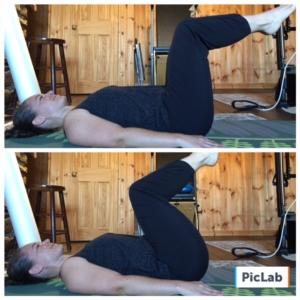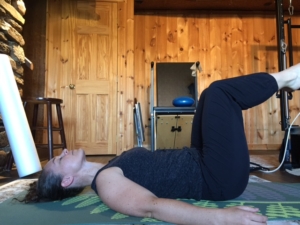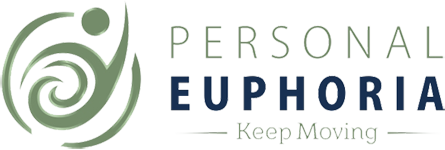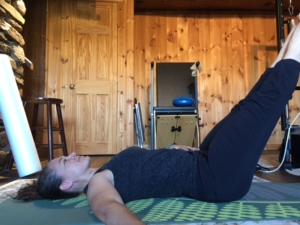Most people I’ve met want fabulous abs. Others are looking for ways to strengthen and support their back knowing that abs play a roll. Whichever desire motivates us (and sometimes it’s both), we often make time for ab exercises. That’s great, but if you’re going spend time doing ab workouts, let’s make sure you are working them the best you can without hurting other parts of your body. Here are some ways to get the most out of your ab workouts.
-
Knees over Hips

It’s really easy for the knees to creep in, but keeping them over your hips will create a lot more ab work.
There are lots of exercises for the abs where the legs are in the bent in the air. Often on these exercises the knees start to creep in over the stomach instead of staying over the hips. If that happens because you are taking pressure off the back, that’s a form of modifying, but know that you want to build up to being able to support your legs in tabletop position (with the knees and hips at 90-degrees). It’s not worth straining the back over, but when you can keep the legs in that position you’ll be targeting your abs more. If your knees are accidently creeping in, experiment with getting them right over your hips. You should feel your abs working a ton more. If you don’t, make sure you abs are working and staying engaged.
-
Maintain Imprint
Imprint is when you press your lower back toward the ground, slightly tucking the tailbone between your legs. We use it as a tool to keep the back safe while doing exercises with the legs in the air. When we are imprinted with the legs in the air, it’s extremely hard to hold imprint. Very fit people often take this challenge for granted. If you move the legs too far away from your torso and lose imprint, you might feel like you are make the exercise bigger. The bigger motion may mentally feel better like we are doing more, but really, if the back arches, you have lost the connection with the abs and are putting the back at risk. That doesn’t mean you can’t safely do an exercise in neutral with the legs in the air. But it’s one thing to make a decision to work in neutral and another to lose your connection and wind up in neutral, or worse beyond neutral with a large arch in your low back. If you are UNABLE to maintain imprint when you intend to with the legs in the air, it’s not worth moving the legs much. Move less. Get more ab work. The movement might feel a lot smaller, but your abs will be getting a much bigger workout.
-
Variety
We have multiple abdominal muscles. They can bend us side to side, curl us up, rotate us and support our spine. Use them all. People often focus on curling up and down and oblique twists, but remember you can work the abs by lifting the upper body off the floor or bringing the legs into the air when you are lying on your back. You can work the abs in a plank position without the body even moving or you can sit tall and hinge away from your thighs and work your abdominals on the long end. You can sit still and actively engage your abdominals and release them. Change up your routine and get the most out of your ab work.
-
Stop Flinging and Thrusting
It’s really frustrating when you can’t do an exercise yet. But using momentum to get yourself up puts your neck and back at risk without strengthening your abs. Trying to build strength that way will never get you the results you want. You’ll always have to thrust yourself up. Break down the exercise. Try to stop worrying about whether you get up and instead work to feel your abdominal muscles as much as you can. This can be really frustrating, I know. But think of the line, “it’s the journey, not the destination.” That’s true when we are working the abs. Thrusting the body up to make it look like we are doing a particular ab exercise isn’t really doing it. Doing the part you can currently do may not feel like you are doing the full exercise either, but at least you are working your abs.
-
Work Eccentrically
Remember to work the abs on the long end. An eccentric contraction is when the muscle gets longer. You don’t always have to round forward or curl to work the abs. You can sit up tall and hinge away from your legs. This will help with upright posture. We live in a world where we slouch so curling up all the time can exacerbate the problem. When you do exercises that bend you backward and focus on the upper back, recognize those are important for the abdominals too. The abs need to extend and lengthen.
-
Check-in: Do You Feel Your Abs

Look how uncomfortable and tense my neck and shoulders are here. When that happens other muscles are firing to do the work of the abs.
It’s really easy to move through an exercise, especially one you think you know well, and miss all the gains. Take time to notice if you are feeling your abs. If the answer is no, it’s time to alter the way you are doing the movement so you can feel them. If the answer is yes, next ask whether you feel anything else. Is your back or neck sore or working? If they are straining, it’s also time to alter the exercise. If they are working, it’s possible they are helping the abs and there might be a way for you to feel your abs even more. Do your shoulders pop up to help the abs? Can you relax them.
Want more Personal Euphoria?
Follow the Personal Euphoria Facebook page, follow Personal Euphoria on Instagram, and subscribe to the Personal Euphoria YouTube Channel.


Thanks, Maggie…you are such a good teacher and a wonderful mentor…
As always, thanks for reading. And I love having you in class!